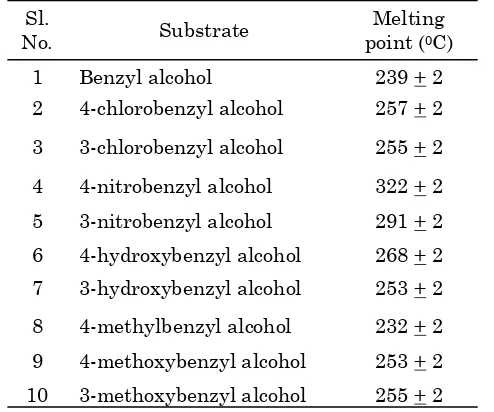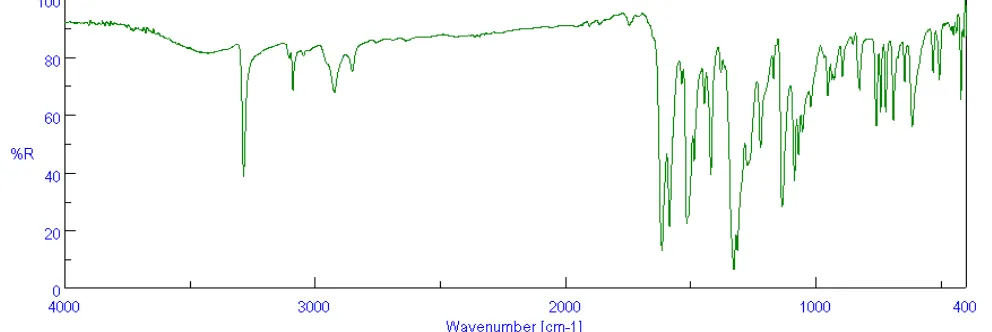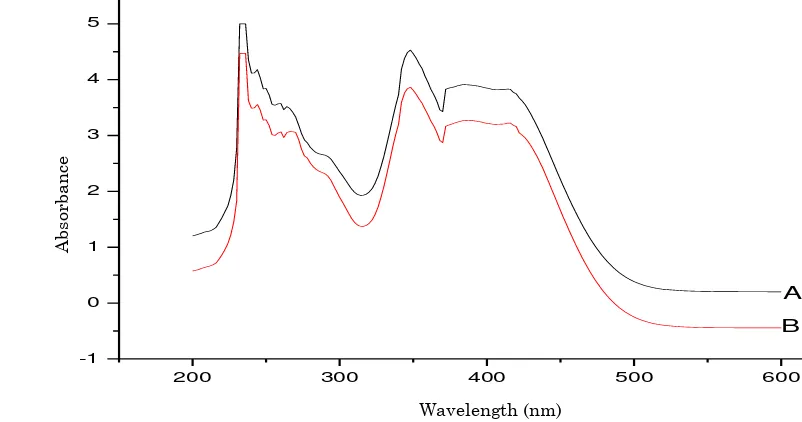Selective Synthesis of Benzaldehydes by Hypochlorite
Oxidation of Benzyl Alcohols under Phase Transfer
Catalysis
K. Bijudas1*, P. Bashpa1, V. P. Bibin2, Lakshmi Nair2, A. P. Priya2, M. Aswathy2, C. Krishnendu2, P. Lisha2
1 Department of Chemistry, N. S. S. College, Manjeri, Malappuram, Kerala - 676122, India 2 Graduate Students, Department of Chemistry, N. S. S. College, Manjeri, Malappuram, Kerala -
676122, India
* Corresponding Author.
E-mail: [email protected] (K. Bijudas) Tel: +91 9447170209, Fax: +91 483 2766202
Bulletin of Chemical Reaction Engineering & Catalysis, 10 (1), 2015, 38-42
Received: 10th August 2014; Revised: 20th September 2014; Accepted: 21st September 2014
Abstract
The selective synthesis of benazaldehyde and substituted benzaldehydes from corresponding benzyl al-cohols has been carried out by using hypochlorite as an oxidant in organic medium under phase trans-fer catalysis. The reaction is highly selective since no traces of benzoic acid or substituted benzoic acids have been detected and the yield is found to be more than 90%. The products obtained were precipi-tated as 2,4-dinitrophenylhydrazone and the recrystallised products were characterized by melting point and by spectrophotometric techniques like infra red and UV-Visible analysis. © 2015 BCREC UNDIP. All rights reserved.
Keywords: Selective synthesis; Hypochlorite; Benzyl alcohol; Substituted benzyl alcohols; Phase trans-fer catalysis
How to Cite: Bijudas, K., Bashpa, P., Bibin, V. P., Nair, L., Priya, A. P., Aswathy, M., Krishnendu, C., Lisha, P. (2015). Selective Synthesis of Benzaldehydes by Hypochlorite Oxidation of Benzyl Alcohols under Phase Transfer Catalysis. Bulletin of Chemical Reaction Engineering & Catalysis, 10 (1): 38-42. (doi:10.9767/bcrec.10.1.7189.38-42)
Permalink/DOI: http://dx.doi.org/10.9767/bcrec.10.1.7189.38-42
Available online at BCREC Website: http://bcrec.undip.ac.id
Research Article
1. Introduction
Oxidation reactions using different oxidizing agents are having great significance in synthe-sis of various organic compounds [1-2]. The in-troduction of phase transfer catalysis (PTC) has revolutonalised organic synthesis in re-spect of anion dissolution in non polar solvents with their ability to catalyse the reaction. PTC is one of the most efficient methods that can be used to carry out a variety of chemical reac-tions under mild condireac-tions with improved
Benzaldehyde is an important starting pound for the manufacture of various com-pounds like dyes, odorants, flavours, perfumes etc. Currently benzaldehyde is produced by the direct oxidation of toluene or by side chain chlorination of toluene followed by hydrolysis of benzal chloride. Both these methods have dis-advantages like requirement of high tempera-ture, low yield, formation of by-products etc. transferred hypochlorite as a selective oxidant in organic solvents is scanty and this prompted us to carry out this work.
The present paper reports the selective oxi-dation of benzyl alcohol and substituted benzyl alcohols to corresponding benzaldehydes by us-ing various quaternary ammonium and phos-phonium salts as PT catalysts in various or-ganic solvents like ethyl acetate and toluene by hypochlorite. PT catalyst transfers the hy-pochlorite ion as an ion pair from the aqueous phase to organic phase and the oxidation occurs there with ease.
2. Materials and Methods
2.1. Materials
5% solution of sodium hypochlorite (NICE Chemicals, India) was used as such in the en-tire process. Benzyl alcohol (AR) was further purified by distillation under reduced pressure. The substituted benzyl alcohols, 4-hydroxybenzyl alcohol, 3-4-hydroxybenzyl hol, 4-chlorobenzyl alcohol, 3-chlorobenzyl alco-hol, 4-methoxybenzyl alcoalco-hol, 3-methoxybenzyl alcohol, 4-nitrobenzyl alcohol, 3-nitrobenzyl al-cohol and 4-methylbenzyl alal-cohol (spectrochem, India Ltd. Mumbai and Merck KGaA, Ger-many) were used, such as tetrabutylammonium bromide (TBAB), tetrabutylammonium hydro-gen sulphate (TBAHS), cetyltrimethylammo-nium bromide (CTMAB) (Spectrochem India Ltd. Mumbai), and tetrabutylphosphonium
bro-Synthetic analysis was carried out in hetero-geneous manner. Benzyl alcohol and
substi-tuted benzyl alcohols (0.1 mol) dissolved in 50 ml toluene or ethyl acetate which contains 0.01 mol PT catalyst was mixed with 50 ml sodium hypochlorite. The mixture was stirred vigor-ously using a magnetic stirrer for about thirty minute at room temperature. The organic layer was extracted with ether three times. This organic layer was again extracted with 10% sodium bicarbonate and both organic and aqueous layers were separated. A saturated so-lution of 2,4-dinitrophenylhydrazine in HCl was added to the organic layer and kept over-night in refrigerator. The obtained product pre-cipitated as 2,4-dinitrophenylhydrazone (DNP) was filtered off, recrystallised from ethanol, dried and weighed. The product obtained was analysed by its melting point and other qualita-tive analytical methods like UV-Visible spectro-photometer and IR spectrospectro-photometer. The aqueous layer after extraction with sodium bi-carbonate was acidified with concentrated HCl to detect the presence of acid.
3. Results and Discussion
Benzyl alcohol and substituted benzyl alco-hols on oxidation under heterogeneous condi-tion gave corresponding aldehyde as the prod-uct with very high yield (above 90%). The oxi-dation reaction was carried out at room tem-perature and there was no further oxidation to acid. This is evident from the absence of ben-zoic acid or substituted benben-zoic acids in the re-action mixture. The recrystallised sample of products in the form of 2, 4 -
dinitrophenylhy-Bulletin of Chemical Reaction Engineering & Catalysis, 10 (1), 2015, 39
Table 1. Melting point of products in the form of 2,4-dinitrophenylhydrazone on oxidation of ben-zyl alcohol and substituted benben-zyl alcohols
drazone were characterized by its melting point and is given in Table 1.
The obtained results of melting point were compared with the values of authentic samples and found to have excellent similarities. This showed that the products obtained may be cor-responding aldehyde. This was further con-firmed by IR and UV- Visible spectral analysis by taking benzyl alcohol as the typical sub-strate.
The infra red absorption spectrum was re-corded from KBr pellets using Jasco FT-IR 4100 spectrophotometer (Japan) and is shown in Figure 1. The IR spectrum showed sharp Presence of all these peaks leads to the conclu-sion that the product formed may be 2,4-dinitrophenylhydrazone of benzaldehyde. Fur-thermore this spectrum was compared with the IR spectrum of 2,4-dinitrophenylhydrazone of pure benzaldehyde and found to have excellent similarities.
UV-Visible absorption of the product ob-tained on the oxidation of benzyl alcohol was recorded by Hitachi U-3000 UV-Visible photometer using 1 cm quartz cell and spectro-grade ethanol (Merck, India) as solvent and is given in Figure 2. In the UV-Visible spectrum of 2,4-dinitrophenylhydrazone of the product on the oxidation of benzyl alcohol showed intense peaks at 235 nm and 353 nm and were as-signed to p-p* and n-p* transition of the nitro-gen containing aromatic compound. The UV-Visible spectrum of the obtained product was compared with the UV-Visible spectrum 2, 4-dinitrophenylhydrazone of pure benzaldehyde
and gave excellent similarities.
All the above analyses, viz., melting point determination, IR and UV-Visible spectral studies showed that the product formed on the oxidation of benzyl alcohol and substituted ben-zyl alcohols by hypochlorite under phase trans-fer catalysis was corresponding benzaldehyde. The reaction was found to be very smooth in both the solvents, namely ethyl acetate and toluene. But the yield of benzaldehyde and ease of reaction was found to be more in ethyl ace-tate than that in toluene. This may be due to the fact that ethyl acetate is more polar than toluene. Solubility and partitioning of quater-nary salts are increased by increase in the po-larity of the organic phase.
All the four catalysts were found to be very effective in the oxidation reaction but the yield and ease of reaction is in the order TBPB > TBAB > TBAHS > CTMAB. This may be due to the changes in combination of alkyl groups or may be due to the difference in the activity of anions for phase transfer. The primary require-ment of the alkyl groups in PT catalysts is that they collectively should have sufficient organic structure to transfer the desired anion into the organic phase. A catalyst, which is soluble in organic phase, will be better in phase transfer catalysed reactions involving anion transfer from aqueous to organic phase. The larger alkyl groups with almost symmetric structure are most effective both in anion transfer and in re-activity. Quaternary ammonium and phospho-nium salts have been successfully used as PT catalysts. Commercially, ammonium salts are more widely available in a large variety of or-ganic structures and are less expensive. Phos-phonium salts are thermally stable up to 150-170 oC, where as ammonium salts lose their ac-tivity at temperature greater than 110 oC. The activity of a quaternary salt as a PT catalyst
Bulletin of Chemical Reaction Engineering & Catalysis, 10 (1), 2015, 40
depends on the anion originally present. The quaternary salts are useful as PT catalysts only if the anion accompanying the catalyst is dis-tributed in the organic phase to a much lesser extent than the anion to be reacted. In general, the large, lipophilic quaternary cations are soft in the HSAB concept, so that this cation tends to pair with the softest anions available in the solution and transfer it into the organic phase. The more commonly used catalysts have chlo-ride, bromide or hydrogen sulphate as the an-ion moiety. These facts can be used to explain the order of reactivity of various PT catalysts. The mechanism of the reaction is given in Scheme 1.
4. Conclusions
In summary, a simple, efficient, selective green method for the conversion of benzyl alco-hols to corresponding benzaldehydes under phase transfer catalysis was reported. Hy-pochlorite was found to be very effective selec-tive oxidant in the oxidation of benzyl alcohols under PTC. Greener solvents were used for this conversion and there was no formation of
by-Bulletin of Chemical Reaction Engineering & Catalysis, 10 (1), 2015, 41
products. So this method under PTC can be adapted to other reaction systems also and for such reactions under solvent free conditions.
References
[1] Lee, D.G. (1980). Oxidation of organic com-pounds by permanganate ion and hexavalent
chromium: Open Court: La Salle.
[2] Wiberg, K.B. (1965). Oxidation in organic
chemistry: Academic Press, London and New York.
[3] Starks, C.M., Liotta, C. (1978). Phase transfer
catalysis, Principles and Techniques:
Aca-demic Press, New York.
[4] Dehmlow, E.V., Dehmlow, S.S. (1993). Phase
transfer catalysis: VCH: Weinheim, Germany.
[5] Sasson, Y., Neumann, R. (1993). Handbook of
Phase Transfer Catalysis: Kluwer Academic
Publishers, Dordrecht.
[6] Pletcher, D., Tait, S.J.D. (1979). A procedure for the oxidation of alcohols to aldehydes based on phase transfer catalysis. Journal of the Chemical Society, Perkin Transactions,
2(6): 788-791.
Q
+OCl
-+ PhCH
2OH PhCHO + Q
+Cl
-+H
2O Organic phase.
--- Phase boundary
Q
+OCl
-+ Na
+X
-Na
+OCl
-+ Q
+X
-Aqueous phase.
Scheme 1. Oxidative conversion of benzyl alcohols to corresponding benzaldehydes
Figure 2. UV-Visible spectrum of (A): 2,4-dinitrophenylhydrazone of pure benzaldehyde; (B): 2,4- di-nitrophenylhydrazone of product on the oxidation of benzyl alcohol
200 300 400 500 600
-1 0 1 2 3 4 5
B A
Wavelength (nm)
A
b
so
rb
a
n
Bulletin of Chemical Reaction Engineering & Catalysis, 10 (1), 2015, 42
[7] Yadav, G.D., Mistry, C.K. (2001). Oxidation of benzyl alcohol under a synergism of phase transfer catalysis and heteropoly acids.
Jour-nal of Molecular Catalysis A, 172(1-2):
135-149.
[8] Bijudas, K., Radhakrishnan Nair, T.D. (2004). Selective oxidation of benzyl alcohol with monochromate in non – polar solvents. Indian
Journal of Chemistry, 43A: 1216-1218.
[9] Bijudas, K., Radhakrishnan Nair, T.D. (2014). Kinetics and mechanism of the selective oxi-dation of primary aliphatic alcohols under phase transfer catalysis. Current Chemistry
Letters. 3(2): 109-114. (DOI:10.5267/
j.ccl.2013.12.001).
[10] Basheer, K.M., Joseph, J., Radhakrishnan Nair, T.D. (2013). Kinetics of the oxidation of benzhydrols with permanganate under phase transfer catalysis in organic solvents. Modern
Research in Catalysis,2: 35-38.
[11] Bijudas, K., Bashpa, P., Radhakrishnan Nair
T.D. (2014). Kinetic studies on the selective oxidation of benzyl alcohol and substituted benzyl alcohols in organic medium under phase transfer catalysis. Bulletin of Chemical
Reaction Engineering & Catalysis, 9(2):
142-147. (DOI: 10.9767/bcrec.9.2.6476.142-147).
[12] Wang, M.L., Huang, T.H. (2007). Kinetic study of benzyl alcohol oxidation under phase transfer catalysis conditions, Chemical
Engi-neering Communications, 5: 618-634.
(DOI: 10.1080/00986440600992685)
[13] Abramovici, S., Neumann, R., Sasson, Y. (1985). Sodium hypochlorite as oxidant in phase transfer catalytic systems. Part II. Oxi-dation of aromatic alcohols. Journal of
Mo-lecular Catalysis, 29: 299-303.
[14] Mirafzal, G.A., Lozeva, A.M. (1998). Phase transfer catalysed oxidation of alcohols with sodium hypochlorite. Tetrahedron Letters, 39(40): 7263-7266.
[15] Lee, G.A, Freedman, H.H. (1985). Phase transfer oxidations with hypochlorite: Scope and mechanism. Israel Journal of Chemistry, 26: 229-234.
[16] Do, J.S., Chou, T.C. (1990). Kinetics of the oxidation of benzyl alcohol by hypochlorite ion in the presence of phase transfer catalyst.
In-dustrial & Engineering Chemistry Research,
29: 1095-1103.
[17] Amsterdamsky, C. (1996). PTC Oxidation of alcohols using hydrogen peroxide. Journal of
Chemical Education, 78: 66-67.
[18] Vogel, A.I. (1967). Text book of practical


